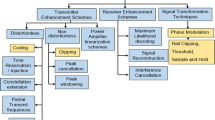Abstract
Recently, almost all the wireless devices are being designed for the fast evolving technology of software-defined radios, which is a radio access technology that most of the signal processing components are implemented digitally in software rather than in hardware to redefine the functionality of components, reduce the cost and complexity of the systems. This paper presents a low cost, portable, and flexible frequency hopping signal record and playback system based on a general purpose software radio front end, the Universal Software Radio Peripheral N210 devices. Further, this paper addresses the different issues such as timing recovery, phase recovery and frequency correction. In addition to that various GNU schematics are created to show the effect of different signal processing blocks on a modulated signal and their corresponding outputs are presented in the view of time domain, frequency domain and waterfall sink.































Similar content being viewed by others
References
Mitola, J. (1992). Software radios-survey, critical evaluation and future directions. In IEEE national telesystems conference, 13/15–13/23.
Arslan, H. (Ed.). (2007). Cognitive radio, software defined radio, and adaptive wireless systems. Berlin: Springer.
Brodtkorb, A. R., Hagen, T. R., & Sætra, M. L. (2013). Graphics processing unit (GPU) programming strategies and trends in GPU computing. Journal of Parallel and Distributed Computing, 73(1), 4–13.
Rondeau, T. http://www.trondeau.com/storage/grcon12/rondeau-mpsk_tutorial.pdf.
Jiayu, G., et al. (2013). GreenBase: An energy-efficient middleware for baseband units in radio access networks. In IEEE wireless communications and networking conference (WCNC).
Lin, J., et al. (2009). Energy-efficient distributed adaptive multisensor scheduling for target tracking in wireless sensor networks. IEEE Transactions on Instrumentation and Measurement, 58(6), 1886–1896.
Knag, P., et al. (2015). A sparse coding neural network ASIC with on-chip learning for feature extraction and encoding. IEEE Journal of Solid-State Circuits, 50(4), 1070–1079.
Brejza, M. F., et al. (2016). Flexible iterative receiver architecture for wireless sensor networks: A joint source and channel coding design example. IET Wireless Sensor Systems, 7(2), 27–34.
Meteoglu, E., & Jintaseranee, K. (2016). Access network type identification in mobile internet protocol (MIP) registration (RRQ). U.S. Patent No. 9,241,350.
Reddy, B. S. K. (2016). Performance improvement techniques for OFDM system using software defined radio. Wireless Personal Communications, 91(3), 1065–1083.
GNU Radio. http://gnuradio.org/.
Proakis, J. G. (1995). Digital communications. New York: McGraw-Hill.
Hanna, S. S., El-Sherif, A. A., & ElNainay, M. Y. (2016) Maximizing USRP N210 SDR transfer rate by offloading modulation to the on-board FPGA. In 2016 International Conference on Wireless Networks and Mobile Communications (WINCOM). IEEE.
Rondeau, T. http://gnuradio.squarespace.com/examples.
Zocher, A. G., et al. (2016). Receiver automatic gain control (AGC) and slicer. U.S. Patent No. 9,521,405.
Wang, Z., Wenchuan, W., & Zhang, B. (2016). A fully distributed power dispatch method for fast frequency recovery and minimal generation cost in autonomous microgrids. IEEE Transactions on Smart Grid, 7(1), 19–31.
Nasr, I., et al. (2016). Performance study of a near maximum likelihood code-aided timing recovery technique. IEEE Transactions on Signal Processing, 64(3), 799–811.
Rondeau, T. (2016). https://static.squarespace.com/static/rondeau-03-digital_demodulation.pdf.
Bianchi, G., et al. (2016). Hidden oscillations in SPICE simulation of two-phase Costas loop with non-linear VCO. IFAC-PapersOnLine, 49(14), 45–50.
Author information
Authors and Affiliations
Corresponding author
Additional information
Publisher's Note
Springer Nature remains neutral with regard to jurisdictional claims in published maps and institutional affiliations.
Rights and permissions
About this article
Cite this article
Reddy, B.S.K. Experimental Validation of Timing, Frequency and Phase Correction of Received Signals Using Software Defined Radio Testbed. Wireless Pers Commun 101, 2085–2103 (2018). https://doi.org/10.1007/s11277-018-5806-2
Published:
Issue Date:
DOI: https://doi.org/10.1007/s11277-018-5806-2




